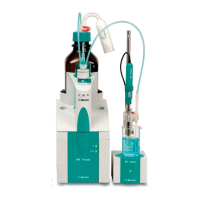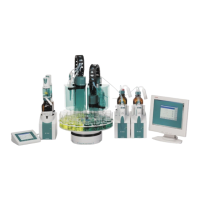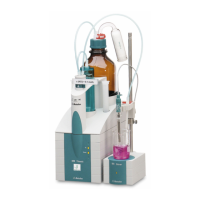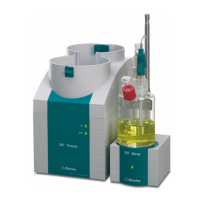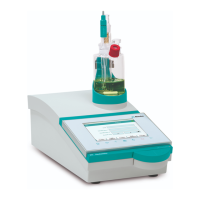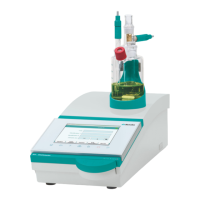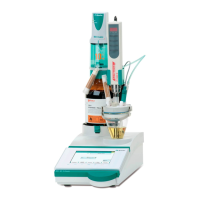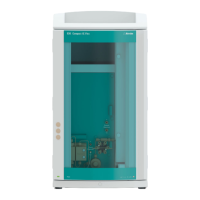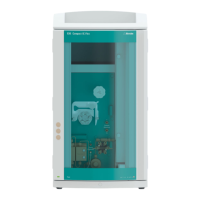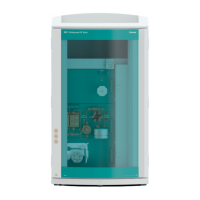Do you have a question about the Metrohm 905 Titrando and is the answer not in the manual?
Overview of the Titrando system and its peripheral devices.
Details the characteristics of the 905 Titrando, including operation, connectors, and interfaces.
Lists and explains various titration modes, measuring modes, and dosing commands.
Information regarding the manual's structure, symbols, and warnings.
Explains symbols, formatting, and warnings used in the documentation.
Provides general safety guidelines and specific warnings for instrument operation.
General safety precautions for operating the instrument.
Safety measures related to electrical connections and components.
Safety precautions when handling liquids, including checking for leaks.
Safety measures for working with flammable materials.
Information on the proper disposal of the instrument.
Steps for unpacking, checking, and locating the instrument.
Instructions for handling and keeping the instrument's packaging.
Procedures for checking the shipment for completeness and damage.
Guidelines for choosing a suitable operating location for the instrument.
Instructions for connecting control units like Touch Control or a PC.
Describes the two operating modes: Touch Control and PC software.
Step-by-step guide to connect and operate the Touch Control.
Steps for connecting the 905 Titrando to a computer for PC software control.
Information on connecting Metrohm Serial Bus (MSB) devices like stirrers and dosing units.
Steps for connecting a dosing device to the MSB interface.
Guide on connecting stirrers and titration stands via MSB.
Instructions for connecting the Remote Box for controlling external devices.
General information on connecting USB peripheral devices.
Overview of the two USB ports and their function as a hub.
Guide for connecting additional USB devices using a hub.
Steps for connecting and configuring a printer via USB.
Details on connecting various balance models using different cables and adapters.
Instructions for connecting a PC keyboard for text and numerical input.
Guide for connecting and configuring a barcode reader via USB.
Overview of measuring inputs and connecting various sensor types.
Steps for connecting a pH, metal, or ion-selective electrode.
Instructions for connecting a reference electrode.
Steps for connecting a polarizable electrode.
Guide for connecting temperature sensors.
Instructions for connecting the 854 iConnect measuring interface.
Discusses potentiometric measurements and potential issues in low conductivity media.
Importance of proper mixing and positioning of stirrer, electrode, and buret tip.
General care and maintenance advice for the instrument.
Guidelines for proper cleaning and protection against contamination.
Information on annual service and maintenance by authorized personnel.
Support for quality management, installation, and operational qualification.
General troubleshooting tips for common issues like the "On" LED.
Troubleshooting specific problems encountered during SET titration.
Details on the Remote Box and its connectors for controlling devices.
Explains the pin assignments for remote sockets and plugs.
Specifications for potentiometry, temperature, and polarization measuring inputs.
Technical details for potentiometric measurements.
Specifications for temperature measurement inputs.
Specifications for polarizable electrode measurements.
Electrical specifications including voltage, frequency, and power consumption.
Lists safety standards for design and testing.
Details EMC standards fulfilled for emission and immunity.
Specifies operating, storage, and transport temperature ranges.
Defines reference conditions for measurements, including temperature and humidity.
Provides physical dimensions, weight, and material of the instrument.
Lists and describes USB, controller, and MSB interfaces.
Overview of the Titrando system and its peripheral devices.
Details the characteristics of the 905 Titrando, including operation, connectors, and interfaces.
Lists and explains various titration modes, measuring modes, and dosing commands.
Information regarding the manual's structure, symbols, and warnings.
Explains symbols, formatting, and warnings used in the documentation.
Provides general safety guidelines and specific warnings for instrument operation.
General safety precautions for operating the instrument.
Safety measures related to electrical connections and components.
Safety precautions when handling liquids, including checking for leaks.
Safety measures for working with flammable materials.
Information on the proper disposal of the instrument.
Steps for unpacking, checking, and locating the instrument.
Instructions for handling and keeping the instrument's packaging.
Procedures for checking the shipment for completeness and damage.
Guidelines for choosing a suitable operating location for the instrument.
Instructions for connecting control units like Touch Control or a PC.
Describes the two operating modes: Touch Control and PC software.
Step-by-step guide to connect and operate the Touch Control.
Steps for connecting the 905 Titrando to a computer for PC software control.
Information on connecting Metrohm Serial Bus (MSB) devices like stirrers and dosing units.
Steps for connecting a dosing device to the MSB interface.
Guide on connecting stirrers and titration stands via MSB.
Instructions for connecting the Remote Box for controlling external devices.
General information on connecting USB peripheral devices.
Overview of the two USB ports and their function as a hub.
Guide for connecting additional USB devices using a hub.
Steps for connecting and configuring a printer via USB.
Details on connecting various balance models using different cables and adapters.
Instructions for connecting a PC keyboard for text and numerical input.
Guide for connecting and configuring a barcode reader via USB.
Overview of measuring inputs and connecting various sensor types.
Steps for connecting a pH, metal, or ion-selective electrode.
Instructions for connecting a reference electrode.
Steps for connecting a polarizable electrode.
Guide for connecting temperature sensors.
Instructions for connecting the 854 iConnect measuring interface.
Discusses potentiometric measurements and potential issues in low conductivity media.
Importance of proper mixing and positioning of stirrer, electrode, and buret tip.
General care and maintenance advice for the instrument.
Guidelines for proper cleaning and protection against contamination.
Information on annual service and maintenance by authorized personnel.
Support for quality management, installation, and operational qualification.
General troubleshooting tips for common issues like the "On" LED.
Troubleshooting specific problems encountered during SET titration.
Details on the Remote Box and its connectors for controlling devices.
Explains the pin assignments for remote sockets and plugs.
Specifications for potentiometry, temperature, and polarization measuring inputs.
Technical details for potentiometric measurements.
Specifications for temperature measurement inputs.
Specifications for polarizable electrode measurements.
Electrical specifications including voltage, frequency, and power consumption.
Lists safety standards for design and testing.
Details EMC standards fulfilled for emission and immunity.
Specifies operating, storage, and transport temperature ranges.
Defines reference conditions for measurements, including temperature and humidity.
Provides physical dimensions, weight, and material of the instrument.
Lists and describes USB, controller, and MSB interfaces.
| Brand | Metrohm |
|---|---|
| Model | 905 Titrando |
| Category | Laboratory Equipment |
| Language | English |
